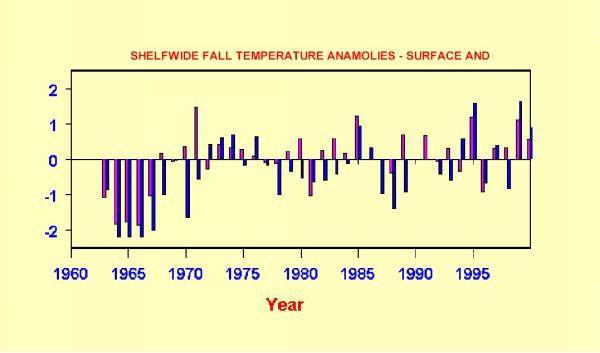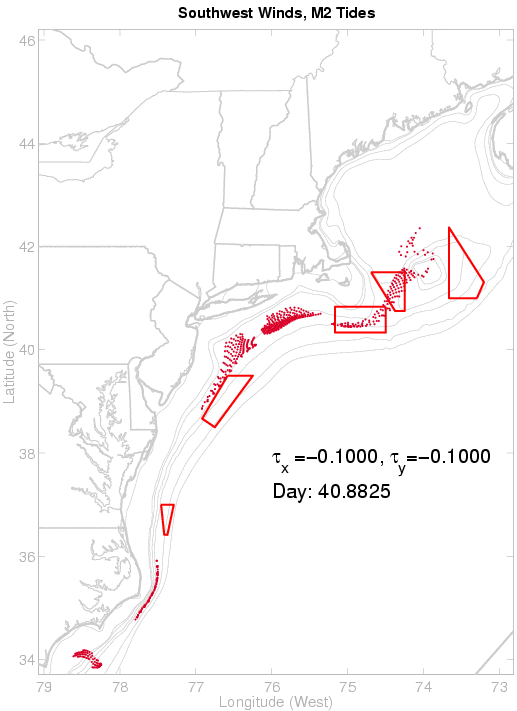Science Talks
 Science Talk I - Dave Mountain of the Northeast Fisheries Science
Center gave an excellent presentation on the potential consequences of climate
change on fish resources in the NW Atlantic/Georges Bank region. His study area
included both the Gulf of Maine and the Middle Atlantic Bight. Dave noted that
there were approximately 180 species of fish in the region and that 60% of
these were cold temperate, the rest warm temperate species. The region is
therefore a faunal transition area. The Gulf of Maine mixes water from two
main sources. The first source is cool, fresh water from the Scotain Shelf. The second
input is warm salty slope water. Temperature changes are expected to be in
the 2 to 4° range. However, the temperature in any one place can vary
12-20° annually and 2-4° changes seem minor. There should also be
an increase in the Labrador Current. However, both of these changes should
increase stratification and this is perhaps where the important differences
are. Additionally, stratification involves some nonlinearities and strong
feedback mechanisms. For example there can be 20% more buoyancy produced from a
unit of heat at 6.5° than at 4.5°.
Science Talk I - Dave Mountain of the Northeast Fisheries Science
Center gave an excellent presentation on the potential consequences of climate
change on fish resources in the NW Atlantic/Georges Bank region. His study area
included both the Gulf of Maine and the Middle Atlantic Bight. Dave noted that
there were approximately 180 species of fish in the region and that 60% of
these were cold temperate, the rest warm temperate species. The region is
therefore a faunal transition area. The Gulf of Maine mixes water from two
main sources. The first source is cool, fresh water from the Scotain Shelf. The second
input is warm salty slope water. Temperature changes are expected to be in
the 2 to 4° range. However, the temperature in any one place can vary
12-20° annually and 2-4° changes seem minor. There should also be
an increase in the Labrador Current. However, both of these changes should
increase stratification and this is perhaps where the important differences
are. Additionally, stratification involves some nonlinearities and strong
feedback mechanisms. For example there can be 20% more buoyancy produced from a
unit of heat at 6.5° than at 4.5°.
If one examines fall temperature anomalies over the entire shelf, the 1960's
were cool and then temperatures have moved back and forth. Some fish exhibit
distributional shifts within this time frame. Mackerel distributions were
southerly in 1968 when compared to 1974 when it was warmer. A relationship
seems to exist between mackerel latitude and temperature. Haddock, with a
different life history and spawning strategy, did not exhibit a large change in
distribution. They did, however, seem to use deeper water as temperatures
increased on the Bank. This implies that the impact may be taxa or species
specific. While mackerel may change latitude, haddock may change where they
are located on the Bank. Both of these factors can impact population dynamics.
Retention on Georges Bank is dependent on location. If haddock spawn in deeper
water, retention on the Bank may suffer. Also, haddock may move into a region
where there are stronger predator/prey interactions with larval gadids.
Additionally, temperature will influence physiological rates.
There have
also been significant changes in the volume ratio of the sources for the Gulf
of Maine from between the mid 1970s and the early 1990s. Between 1976 and 1979
65%(35%) of the water entiring the GOM came from the slope(Scotian Shelf).
Between 1993 and 1996 this ratio had virtually reversed and with only
32%(68%)from the slope(Scotian Shelf). These differences are significant and will have very
important implications for the physics and biology of the entire study
region.
It is likely the case that these changes have their origins in
processes such as NAO. If we can understand the local manifestation of these
processes and place the life history within that framework, we may be able to
address climate change concerns in a meaningful way.
 Science Talk II - John Quinlan, new to
the program office as of June, gave a science talk which focused on how GLOBEC
technology could be used in the design and assessment of Marine Protected Areas
in the coastal ocean. This essentially represents an effort to move toward an
operational setting for the GLOBEC models. The talk covered individual-based
and hydrodynamic modeling which contributed to the South Atlantic Bight
Recruitment Experiment and Georges Bank GLOBEC.
In an extension of Craig Lewis'
work, these techniques are being applied to sea scallop population dynamics
along the east coast of the United States. Initial results are suggestive of
connectance between different scallop subpopulations from Georges Bank to the
Virginia Beach area. This talk led to a discussion of defining habitats of
special concern (ie, those supplying recruits to particular areas) and how to
use the modeling to define areas that are unsuitable for marine reserves due to
a lack of connectance. Questions of how to properly handle zooplankton and
other biological fields were raised, especially with respect to small scale
patchiness and microstructure.
Science Talk II - John Quinlan, new to
the program office as of June, gave a science talk which focused on how GLOBEC
technology could be used in the design and assessment of Marine Protected Areas
in the coastal ocean. This essentially represents an effort to move toward an
operational setting for the GLOBEC models. The talk covered individual-based
and hydrodynamic modeling which contributed to the South Atlantic Bight
Recruitment Experiment and Georges Bank GLOBEC.
In an extension of Craig Lewis'
work, these techniques are being applied to sea scallop population dynamics
along the east coast of the United States. Initial results are suggestive of
connectance between different scallop subpopulations from Georges Bank to the
Virginia Beach area. This talk led to a discussion of defining habitats of
special concern (ie, those supplying recruits to particular areas) and how to
use the modeling to define areas that are unsuitable for marine reserves due to
a lack of connectance. Questions of how to properly handle zooplankton and
other biological fields were raised, especially with respect to small scale
patchiness and microstructure.
 Science Talk I - Dave Mountain of the Northeast Fisheries Science
Center gave an excellent presentation on the potential consequences of climate
change on fish resources in the NW Atlantic/Georges Bank region. His study area
included both the Gulf of Maine and the Middle Atlantic Bight. Dave noted that
there were approximately 180 species of fish in the region and that 60% of
these were cold temperate, the rest warm temperate species. The region is
therefore a faunal transition area. The Gulf of Maine mixes water from two
main sources. The first source is cool, fresh water from the Scotain Shelf. The second
input is warm salty slope water. Temperature changes are expected to be in
the 2 to 4° range. However, the temperature in any one place can vary
12-20° annually and 2-4° changes seem minor. There should also be
an increase in the Labrador Current. However, both of these changes should
increase stratification and this is perhaps where the important differences
are. Additionally, stratification involves some nonlinearities and strong
feedback mechanisms. For example there can be 20% more buoyancy produced from a
unit of heat at 6.5° than at 4.5°.
Science Talk I - Dave Mountain of the Northeast Fisheries Science
Center gave an excellent presentation on the potential consequences of climate
change on fish resources in the NW Atlantic/Georges Bank region. His study area
included both the Gulf of Maine and the Middle Atlantic Bight. Dave noted that
there were approximately 180 species of fish in the region and that 60% of
these were cold temperate, the rest warm temperate species. The region is
therefore a faunal transition area. The Gulf of Maine mixes water from two
main sources. The first source is cool, fresh water from the Scotain Shelf. The second
input is warm salty slope water. Temperature changes are expected to be in
the 2 to 4° range. However, the temperature in any one place can vary
12-20° annually and 2-4° changes seem minor. There should also be
an increase in the Labrador Current. However, both of these changes should
increase stratification and this is perhaps where the important differences
are. Additionally, stratification involves some nonlinearities and strong
feedback mechanisms. For example there can be 20% more buoyancy produced from a
unit of heat at 6.5° than at 4.5°.  Science Talk II - John Quinlan, new to
the program office as of June, gave a science talk which focused on how GLOBEC
technology could be used in the design and assessment of Marine Protected Areas
in the coastal ocean. This essentially represents an effort to move toward an
operational setting for the GLOBEC models. The talk covered individual-based
and hydrodynamic modeling which contributed to the South Atlantic Bight
Recruitment Experiment and Georges Bank GLOBEC.
In an extension of
Science Talk II - John Quinlan, new to
the program office as of June, gave a science talk which focused on how GLOBEC
technology could be used in the design and assessment of Marine Protected Areas
in the coastal ocean. This essentially represents an effort to move toward an
operational setting for the GLOBEC models. The talk covered individual-based
and hydrodynamic modeling which contributed to the South Atlantic Bight
Recruitment Experiment and Georges Bank GLOBEC.
In an extension of